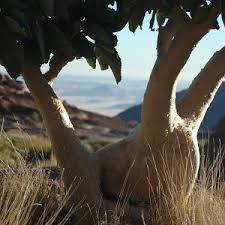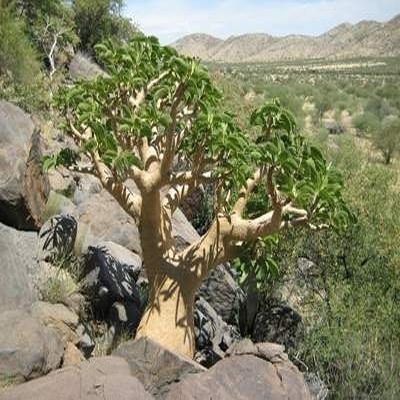Cyphostemma currorii
Cyphostemma currorii
Couldn't load pickup availability
Cyphostemma currorii, also known as the Cobas tree or butter tree, is a succulent tree native to the arid regions of Angola and Namibia. This unique member of the grape family (Vitaceae) is a sought-after plant for gardens and succulent collections due to its thick, water-storing trunk and peeling, papery bark
- Appearance: This deciduous succulent grows into a shrub or small tree, reaching a height of 3 to 6 meters. It has a thick, barrel-shaped trunk that is often multi-stemmed.
- Trunk and bark: The trunk features yellowish to orange bark that peels off in paper-like flakes, revealing the greenish layer underneath. This smooth, water-storing trunk is one of the tree's most striking features.
- Leaves: The large, fleshy, and succulent leaves are divided into three segments (trifoliolate) and are arranged in clusters at the tips of the branches. The leaves have toothed margins and help the plant survive hot seasons.
- Flowers and fruit: In summer, the plant produces small, yellowish-green flowers on long stalks. These are followed by red, grape-like berries in clusters. The berries and foliage are rich in oxalic acid and are poisonous to humans
- Native range: Cyphostemma currorii is native to southern Angola and western Namibia, particularly in the Brandberg and Karibib areas.
- Preferred environment: It thrives in hot, arid, rocky areas, often growing on steep, rocky outcrops. It is adapted to survive extremely dry conditions.
- Sunlight and temperature: The plant requires bright, direct sunlight but may need some afternoon shade in extremely hot climates to prevent leaf burn. It is tolerant of high temperatures and can handle brief periods just above freezing if kept dry.
- Watering: As a drought-tolerant succulent, it should be watered sparingly. Water thoroughly during the summer growing season, allowing the soil to dry out completely between waterings. Keep it dry during its winter dormancy. Overwatering can lead to root rot.
- Soil: Use a sandy, well-draining soil, such as a cactus or succulent mix. Good drainage is essential to prevent rotting.
- Dormancy: C. currorii is deciduous and naturally goes dormant during the dry, cooler winter months, dropping its leaves.
- Propagation: The plant can be propagated from seed or stem cuttings. Seed germination can be slow and erratic, sometimes taking up to two years. Cuttings should be taken during the growing season and allowed to callous before planting in sandy soil.
- Uses: Due to its unique appearance, it makes an excellent accent plant for rockeries, patios, or large containers. Younger plants can be used for bonsai
Price is for 5 seeds


Collapsible content
Fair Use Disclaimer
Our website may contain content not authorized for use by its owner but use of this material falls under the guidelines of fair use (They are for educational purposes only to show the plant only).
If you want to find our more or own any images displayed on our website and disagree with our assessment it constitutes 'fair use' please click here.


